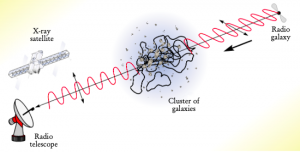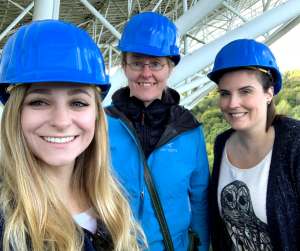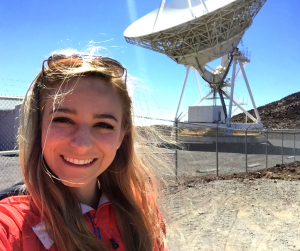A U of T graduate student has discovered that the largest magnetic fields in the Universe are weaker than a fridge magnet – in fact, about three billion times weaker.
PhD student Ariel Amaral from the Dunlap Institute for Astronomy and Astrophysics and the University of Toronto has led a team of researchers that have helped define the strength of magnetism in the Universe.
Unlocking the mysteries of magnetism is a major key to understanding many astronomical processes – such as the formation of stars, planets, and even galaxies.
Astronomers knew that these magnetic fields should exist based on theory, which Amaral explains was the starting point to the project. Because of their weakness, however, they couldn’t be detected before. “So now we know that the largest magnetic fields must be less than 30nG – which for scale was 3 billion times smaller than a fridge magnet,” she says.
Although the physical size of the magnetic fields studied was immense (about 6 quadrillion times larger than the diameter of the Earth), Amaral says the extent of the magnetism’s weakness was not overly surprising. “Magnetic fields even on Earth are quite weak. If these magnetic fields were much stronger you would be able to notice their effects more – such as in how things are shaped in the Universe.”

Faraday Rotation can be used to measure the strength of magnetic fields. Credit: Philipp P. Kronberg, Physics Today, December 2002.
Her process was much more hands-on than previous magnetism research. “Prior to this, it’s mostly been theoretical papers that predicted the strengths of magnetic fields,” Amaral explains, “but those fields have never been directly observed or detected.”
Because the fields can’t actually be viewed, Amaral and her colleagues knew they needed to use an indirect method to observe their effects. To do this, they used radio signals. More specifically, they applied a technique called Faraday Rotation to study the subtle effect magnetic fields have on light. The amount that the polarization of light rotates is directly related to the strength of the magnetism at play.

Amaral with colleagues Dr. Jennifer West and Shannon Vanderwoude, at the Effelsberg 100m Radio Telescope in Germany. Credit: Ariel Amaral.
Amaral’s research results were published in the Monthly Notices of the Royal Astronomical Society in May, 2021.
Relatively speaking, astronomers know very little about the Universe’s magnetism, but this may be about to change. “We’re entering an age where we’ll soon have millions of [radio galaxy] sources to perform the same technique that we used,” explains Amaral.
With these sources, astronomers will be able to more precisely measure the properties of magnetism – things like scale, turbulence, and strength.
“We’re really setting the stage here to actually outright detect these magnetic fields. We’ve kind of set up our research so that as new datasets come out, you can use our technique and get results.”
“This will tell us even more about what was going on at earlier times in the Universe.”
Associated Publication Info:
For more information, please contact:
Meaghan MacSween
Communications and Multimedia Officer
Dunlap Institute for Astronomy & Astrophysics,
University of Toronto
meaghan.macsween@utoronto.ca
The Dunlap Institute for Astronomy & Astrophysics at the University of Toronto is an endowed research institute with more than 90 faculty, postdocs, students and staff, dedicated to innovative technology, ground-breaking research, world-class training, and public engagement. The research themes of its faculty and Dunlap Fellows span the Universe and include: optical, infrared and radio instrumentation; Dark Energy; large-scale structure; the Cosmic Microwave Background; the interstellar medium; galaxy evolution; cosmic magnetism; and time-domain science. The Dunlap Institute for Astronomy and Astrophysics, David A. Department of Astronomy & Astrophysics and the Canadian Institute for Theoretical Astrophysics comprise the leading centre for astronomical research in Canada, at the leading research university in the country, the University of Toronto.

